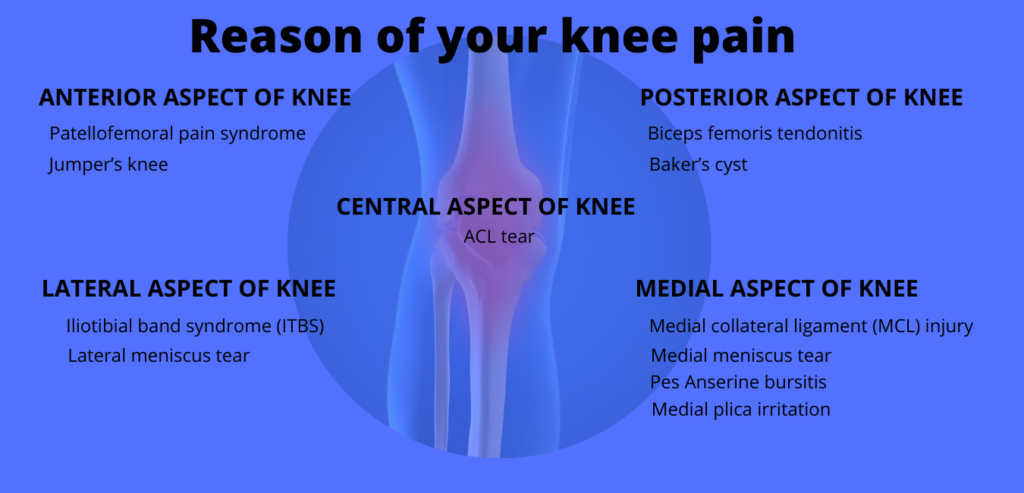Knee pain is a common joint pain problem that affects people of all ages and gender. Knee pain may be the result of an injury, such as a ligament tear or torn cartilage. Medical conditions like arthritis or gout or may be due to infection. Knee pain may be due to a condition affecting the knee joint or the surrounding muscles and soft tissues.
Signs and Symptoms
Signs and symptoms may vary according to the cause of the problem. Few of which are –
- Swelling and stiffness
- Redness and warmth
- Weakness or instability
- Popping or crunching noises
- Inability to fully straighten the knee
Causes of knee pain
Knee pain can be caused by injuries, medical condition and other problems.
Injury related knee pain
Some of the more common knee injuries include:
- Anterior Cruciate Ligament (ACL) injury
- Meniscus tear
- Fractures
- Bursitis
- Tendinitis
Medical conditions which results in knee pain
Arthritis is the most common cause. There are many types of arthritis, such as –
- Osteoarthritis
- Rheumatoid arthritis
- Septic arthritis
- Gout
- Pseudogout
CAUSES OF PAIN IN ANTERIOR ASPECT OF KNEE
Patellofemoral pain syndrome – It is a condition where the cartilage under the kneecap is damaged due to injury or overuse.
Jumper’s knee – An injury to the tissue connecting the kneecap to the shin bone (patellar tendon).
CAUSES OF PAIN IN POSTERIOR ASPECT OF KNEE
Biceps femoris tendonitis – Biceps femoris tendinopathy is inflammation of the biceps femoris tendon which lies to the outside of the back of the knee.
Baker’s cyst – A Baker’s cyst is a fluid-filled sac that causes a bulge in the popliteal region and gives a feeling of tightness behind your knee.
CAUSES OF PAIN IN LATERAL ASPECT OF KNEE
Iliotibial band syndrome (ITBS) – Iliotibial band syndrome occurs when the connective tissue (ligament) extending from the pelvic bone to the shinbone becomes so tight that it rubs against the thighbone.
Lateral meniscus tear – It is an injury to the semi-circular cartilage (meniscus) on the lateral side of the knee joint. It can occur due to sudden twisting or a traumatic injury.
CAUSES OF PAIN IN MEDIAL ASPECT OF KNEE
Medial collateral ligament (MCL) injury – It is an injury of the ligament on the medial side of the knee. The MCL is a band of tissue which connects your thighbone to the bone of your lower leg. Most importantly, it keeps the knee from bending inward.
Medial meniscus tear – It is the injury of menisci due to twisting of knee with the foot anchor on the ground.
Pes Anserine bursitis – Pes anserine bursitis is an inflammation of the bursa located between the shinbone (tibia) and three tendons of the hamstring muscle at the inside of the knee.
Medial plica irritation – There is a pain over the anteromedial aspect of the knees with episodes of crepitation, catching, and pseudo-locking events with activities.
CAUSES OF PAIN IN CENTRAL ASPECT OF KNEE
Anterior Cruciate Ligament (ACL) tear – Anterior Cruciate Ligament (ACL) tear is one of the most common knee injuries. Most ACL tears are a result of a non-contact mechanism such as a sudden change in a direction causing inward rotation of knee.
Diagnosing knee pain
A thorough medical history is necessary to diagnose the cause of your knee pain. Along with this, your doctor will conduct a comprehensive physical examination and, in addition may order a blood test or imaging test. A X-ray of knee joint may be necessary to identify arthritis-related joint damage. Medical practitioner will also use special tests to identify the cause of problem.
Conclusion
There are various causes of knee pain, from injury to medical conditions. Consult your doctor, he will evaluate your knee to make sure you don’t have a serious injury or disorder causing the pain. In addition, he will guide you for the best possible treatment approach.
In short, physiotherapy treatments are very effective in combating knee pain. So, consult a physiotherapist to get the best possible result for your knee pain.

Pingback: How to deal with Anterior Cruciate Ligament (ACL) injury - Physiofitfinder
Pingback: How to deal with Anterior Cruciate Ligament (ACL) injury - Physiofitfinder
Ive got to write about this for a class I am taking, well similar to this. This really made it easier for me , so thanks you A TON.Take care, Shawnta Edelstein
Thank you for another great article. just wanted to throw you a big thanks – you and I’ll bookmark it and come back later